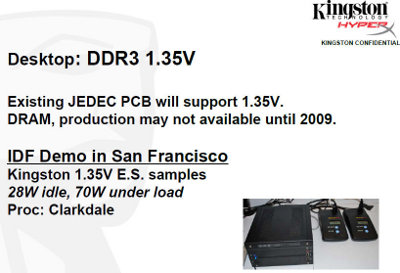Memory of the future
DDR3 memory could soon be in for a bit of a power-cut, according to Kingston, as the company demonstrated DDR3 modules operating at 1.35V instead of the current 1.5V.
At Kingston Headquarters in Fountain Valley, CA, the memory-module maker showed journalists a rather interesting slide, shedding some light on the near-term future of DDR3.

It appears from the slide that Intel's IDF demo of the firm's new 32nm Clarkdale processor on a prototype micro-ATX machine had been running at 28W idle and 70W load, supported by 1.35V DDR3.
Kingston then hinted that the new-and-improved, more energy-efficient DDR3 memory modules would likely become available in both the desktop and notebook space by the start of 2010. And Kingston is not a company that simply talks about products it doesn't plan to release.
JEDEC, the industry standards body, has already mandated that the specification for DDR4, operating at 1.2V, but improvements to DDR3 would certainly be a helpful stepping stone on the path to lower power consumption.
Of course, it's not all down to Kingston; Intel also has a role to play, as well as Kingston's memory-chip supplier partners. But for energy saving's sake, we hope the new power-slimmed memory modules arrive in Kingston's predicted timeframe.
More practical in a notebook environment where every watt counts, motherboard manufacturers will need to modify complete ranges of boards to support the lower power envelope, though.













